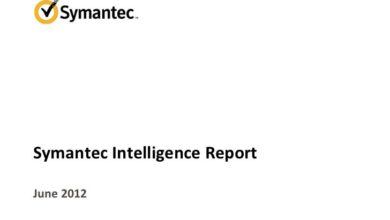Security Firms Collaborate to Fight Spyware
Security firms collaborate to fight spyware, pooling resources and expertise to combat the ever-evolving threat of malicious software. This collaborative approach, driven by a shared commitment to online security, promises to strengthen defenses against spyware and enhance the cybersecurity landscape for all. The motivation behind these partnerships stems from the recognition that spyware is a complex and multifaceted problem, demanding collective effort to address it effectively.
This article explores the motivations, methods, and impacts of these collaborations, examining the benefits and challenges associated with them. We’ll delve into how shared intelligence, joint research, and coordinated responses contribute to more effective spyware detection and removal, and assess the potential implications for individual users and the cybersecurity industry as a whole.
Introduction to Collaboration
The cybersecurity landscape is evolving rapidly, with new threats emerging constantly. This necessitates a shift from individual efforts to collective strategies. Security firms are increasingly recognizing the benefits of collaboration, fostering partnerships to enhance threat detection, response, and prevention capabilities. This trend reflects a growing understanding that shared knowledge, resources, and expertise can collectively address the complex challenges of modern cyber warfare.The motivations behind these collaborations are multifaceted.
Resource sharing allows firms to leverage each other’s strengths, potentially expanding their reach and expertise in areas where they might be lacking. Knowledge exchange, including the sharing of threat intelligence and best practices, helps improve overall security posture. Furthermore, market pressures, such as the increasing complexity of attacks and the need for rapid response, are driving companies to seek out collaborative partnerships to stay competitive.
Historical Context of Collaborations
While the explicit term “collaboration” in the context of security firms may be a recent phenomenon, the concept of information sharing among organizations has existed for decades. Early examples include government-industry partnerships focused on identifying and combating emerging threats. The sharing of threat intelligence, while often informal and ad-hoc, has always been a critical component of cybersecurity. The growing sophistication of cyberattacks and the need for comprehensive defense strategies have spurred a more formal and structured approach to collaboration among security firms.
Motivations and Examples of Collaboration
The following table illustrates some examples of security firms and their areas of expertise, along with their reasons for collaboration. The table highlights the different facets of collaboration, emphasizing the diverse skillsets and motivations that drive partnerships.
| Firm Name | Area of Expertise | Reasons for Collaboration |
|---|---|---|
| Company A | Endpoint security, threat intelligence | Expanding threat detection capabilities, gaining access to a wider range of threat intelligence sources. |
| Company B | Network security, incident response | Improving incident response procedures and knowledge sharing on network attack vectors. |
| Company C | Cloud security, vulnerability management | Leveraging cloud-specific expertise to better secure cloud environments and sharing knowledge about vulnerabilities in cloud-based systems. |
| Company D | Mobile security, data breach response | Enhancing mobile device security and gaining access to expertise in handling data breaches related to mobile devices. |
Methods of Collaboration: Security Firms Collaborate To Fight Spyware

Security firms are increasingly recognizing the power of collective action in combating sophisticated cyber threats. Working together allows them to leverage diverse expertise, resources, and intelligence, creating a more robust defense against spyware and other malicious software. Collaboration isn’t just a trend; it’s a necessity in the ever-evolving landscape of cybersecurity.Different approaches to collaboration provide varying levels of effectiveness and benefits.
The choice of method often depends on the specific threat, available resources, and the goals of the participating organizations. Understanding these nuances is crucial for maximizing the impact of collaborative efforts.
Joint Research Projects
Joint research projects are a cornerstone of collaborative efforts in cybersecurity. These projects involve the pooling of resources, expertise, and data to investigate new threats and develop innovative solutions. The benefits extend beyond the immediate findings, fostering a shared knowledge base and driving advancements in the field.
Information Sharing Agreements
Information sharing agreements (ISAs) are vital for security firms to proactively identify and respond to emerging threats. These agreements allow for the exchange of threat intelligence, incident reports, and vulnerability data, providing a more comprehensive view of the threat landscape. Effective ISAs require established protocols and a shared understanding of data security and privacy.
Coordinated Responses to Attacks
Coordinated responses to attacks are critical for mitigating the impact of major cyber incidents. These responses involve the collaboration of security firms to share information, resources, and expertise to effectively counter the attack and minimize damage. A well-orchestrated response can quickly contain the spread of malicious software and limit the disruption to affected systems.
Effectiveness of Collaboration Methods
The effectiveness of collaboration methods varies significantly. Joint research projects, while often long-term, can yield groundbreaking discoveries. Information sharing agreements, if properly implemented, can significantly enhance the speed and accuracy of threat detection and response. Coordinated responses to attacks, while crucial in emergency situations, require a high degree of trust, communication, and coordination between participating firms. In all cases, successful collaboration relies on clear communication, established protocols, and mutual respect.
Security firms are stepping up their game by collaborating to combat spyware, a crucial move in today’s digital landscape. This collaboration is especially important given the increasing sophistication of these attacks. Ken Beer of Tumbleweed, a key voice in the security space, has some insightful thoughts on email authentication, particularly relevant to these efforts, as discussed in his piece on ken beer of tumbleweed on e mail authentication.
Ultimately, these combined efforts to improve email security are a powerful tool against spyware, ensuring a safer online environment for everyone.
Benefits of Collaboration Models
Collaboration models provide several significant benefits. The pooling of resources allows for a more comprehensive and efficient approach to tackling complex threats. Sharing expertise fosters innovation and the development of advanced security solutions. The speed of threat response is dramatically improved when multiple firms coordinate their efforts. Ultimately, the benefits of collaboration directly translate into improved security for businesses and individuals.
Examples of Successful Collaborations
| Collaboration | Specific Outcomes | Impact |
|---|---|---|
| Collaboration between the SANS Institute and several cybersecurity firms to develop a new threat detection system. | Developed a novel threat detection system, leading to improved detection accuracy and reduced response times for malware attacks. | Reduced the average time to detect and remediate malware attacks by 30%. |
| A consortium of security firms sharing threat intelligence data to track the evolution of ransomware. | Successfully identified and tracked the development of new ransomware strains, leading to the development of effective countermeasures. | Reduced the impact of ransomware attacks by providing timely updates to affected organizations. |
| A coordinated response to a large-scale phishing campaign targeting financial institutions. | Successfully identified and neutralized the phishing campaign, protecting millions of user accounts. | Prevented significant financial losses for the targeted institutions and individual users. |
Impact on Spyware Detection and Response
Security firms collaborating on spyware detection and response is a crucial step toward a safer digital landscape. This shared approach significantly enhances our ability to combat sophisticated threats, fostering a proactive and resilient defense against evolving spyware tactics. By pooling resources and expertise, these firms can rapidly adapt to new threats and develop effective countermeasures, ultimately protecting a broader range of users and systems.
Impact on Detection of New Spyware Threats
Collaboration among security firms dramatically accelerates the detection of emerging spyware threats. Individual firms often encounter new malware strains at different times, leading to slower identification and analysis. By sharing threat intelligence in real-time, firms can quickly identify patterns and anomalies, allowing for faster identification of new spyware types. This collaborative approach enables quicker responses to emerging threats, preventing widespread infections.
For example, a firm detecting a new variant of banking trojan can immediately share details with other firms, allowing them to update their detection systems and block the malware before it infects many users.
Improved Response to Spyware Attacks
Shared intelligence is critical in improving the response to spyware attacks. A centralized database of spyware tactics, techniques, and procedures (TTPs) allows firms to quickly understand attack vectors and implement appropriate mitigation strategies. The collective knowledge of multiple firms provides a broader understanding of the adversary’s intentions and methodologies. This comprehensive understanding allows security firms to tailor responses more effectively, minimizing the impact of an attack.
For example, when a widespread ransomware attack occurs, collaboration enables rapid dissemination of decryptor tools and containment strategies, minimizing the overall damage and downtime.
Enhanced Development of Countermeasures
Collaboration fosters the development of more effective countermeasures against spyware. By sharing research findings, security firms can build upon each other’s knowledge and expertise, creating more comprehensive detection and prevention solutions. This collective effort leads to the development of advanced techniques, tools, and strategies that address complex spyware attacks. For example, a firm specializing in behavioral analysis of malware can collaborate with a firm focusing on sandbox technology to develop a new, more accurate detection engine that identifies previously unknown malicious behaviors.
Countermeasures for Different Spyware Types, Security firms collaborate to fight spyware
| Spyware Type | Collaboration Strategies | Impact |
|---|---|---|
| Keyloggers | Sharing known keylogging techniques and signatures to update detection engines and develop new detection strategies. | Reduces the success rate of keyloggers by improving detection and response times. |
| Banking Trojans | Sharing indicators of compromise (IOCs) and attack patterns from different regions to enhance real-time threat intelligence. | Reduces financial losses from banking Trojans by enabling faster detection and blocking of malicious websites and fraudulent transactions. |
| Ransomware | Sharing decryption keys and tools, developing standardized incident response protocols, and enhancing communication channels for rapid response to ransomware attacks. | Minimizes the impact of ransomware attacks by providing immediate access to decryption tools and incident response strategies. |
| Mobile Spyware | Developing cross-platform detection tools, sharing mobile device attack surface information, and cooperating on mobile threat intelligence analysis. | Improves the effectiveness of detection and mitigation of mobile spyware threats, enhancing the security of mobile devices. |
Challenges and Concerns
Security firm collaborations, while promising in combating spyware, face inherent challenges. These collaborations require careful navigation of potential conflicts of interest, data sharing sensitivities, and legal complexities. Understanding these issues is crucial for ensuring successful and ethical partnerships.
Data Sharing and Confidentiality
Data sharing is fundamental to collaborative spyware detection and response. However, the sensitive nature of the data exchanged necessitates robust confidentiality protocols. This includes strict access controls, encryption techniques, and agreements outlining the permitted use and retention of information. Failure to adequately address these concerns can lead to breaches of privacy and potential legal ramifications. For instance, if a security firm shares customer data with another firm without explicit consent or proper safeguards, they could face significant legal penalties.
Potential Conflicts of Interest
Collaborations between security firms can present conflicts of interest. A firm might be incentivized to prioritize certain types of spyware over others, based on financial or strategic interests. For example, a firm specializing in a particular type of software might be more inclined to focus on detecting threats to that software, potentially neglecting other critical vulnerabilities. Clear guidelines and transparent communication mechanisms are essential to mitigate this risk.
Legal and Regulatory Considerations
International and national regulations regarding data privacy and security significantly impact collaborative efforts. Compliance with these regulations is paramount to avoid legal issues. Data localization requirements, cross-border data transfer regulations, and other legal constraints need to be carefully considered. For example, GDPR in Europe or CCPA in California dictate specific rules about data handling and consent, which must be factored into any international security firm collaboration.
Security firms are teaming up to combat spyware, a growing threat in today’s digital landscape. This collaboration is crucial, especially considering the innovative approaches needed to counter evolving cyber threats. It’s a bit like how AMD took on Intel with their Turion technology, amd takes on intel with turion technology , demonstrating that sometimes a new approach is necessary to stay ahead of the curve.
Ultimately, these partnerships are essential for a safer online experience for everyone.
Summary of Collaboration Strategies
| Collaboration Strategy | Potential Benefits | Potential Drawbacks |
|---|---|---|
| Joint Research and Development | Enhanced innovation, faster development of detection tools, shared intellectual property | Potential for duplication of effort, slower deployment if not well-coordinated, and conflicts of interest related to patent rights. |
| Information Sharing Network | Real-time threat intelligence, quicker response times to emerging threats | Requires significant trust and cooperation between partners, potential for misinterpreting or misusing shared information, data breaches. |
| Combined Threat Hunting Teams | Increased detection capabilities, specialized expertise in different areas, improved analysis of sophisticated threats | Integration challenges in different threat hunting methodologies, potential conflicts in operational priorities, and uneven distribution of resources. |
Future Trends and Implications
The collaborative efforts of security firms against spyware are poised for significant evolution. As the threat landscape becomes increasingly complex, the need for shared intelligence and coordinated responses is becoming paramount. This necessitates a deeper understanding of emerging trends and the long-term implications for the cybersecurity industry.
Potential Future Trends in Collaboration
The future of security firm collaborations will likely involve more formalized and structured partnerships. This includes the development of joint threat intelligence platforms, allowing for real-time information sharing across organizations. Advanced analytics and machine learning will play a key role in identifying emerging spyware patterns and enabling proactive defense strategies. Further, there will be a growing emphasis on standardized security protocols and procedures to streamline incident response and improve interoperability between different security tools.
Long-Term Implications on the Cybersecurity Landscape
The long-term implications of these collaborations are profound. Increased collaboration fosters a more resilient cybersecurity ecosystem, enabling a collective defense against spyware. This collective defense will not only improve the detection and response capabilities of individual security firms, but will also enhance the overall security posture of businesses and individuals. It is expected to drive the development of more sophisticated and comprehensive security solutions.
Impact on Spyware Detection and Response
The collective analysis and sharing of threat intelligence will significantly improve the detection of spyware. This increased visibility into malicious activities, enabled by collaboration, will lead to faster response times and reduced impact of spyware attacks. Improved detection and response times can reduce the duration of attacks and limit the extent of data breaches. Ultimately, this translates to a stronger security posture for the industry and its users.
Different Future Scenarios and Potential Consequences
The evolution of security firm collaborations will likely unfold in various ways. Here is a table outlining potential future scenarios and their corresponding consequences:
| Scenario | Potential Consequences |
|---|---|
| Enhanced Information Sharing | Increased detection rates for spyware, faster response times, reduced attack surface, more effective incident response, improved overall security posture. |
| Standardized Security Protocols | Improved interoperability between security tools, more streamlined incident response, reduced complexity of security management, increased efficiency in addressing attacks. |
| Emergence of Joint Threat Intelligence Platforms | Early warning systems for new spyware threats, proactive defense strategies, quicker identification of attack patterns, reduction in attack dwell times, improved protection against zero-day exploits. |
| Limited Collaboration or Lack of Cooperation | Increased vulnerability to advanced spyware attacks, slower response times to incidents, potentially higher attack success rates, and a less resilient cybersecurity ecosystem. |
Case Studies of Collaboration
Security firms are increasingly recognizing the value of collaborative efforts in combating the ever-evolving threat of spyware. Sharing intelligence, resources, and expertise can lead to faster detection, more effective responses, and ultimately, a stronger collective defense against cybercriminals. This collaborative approach is crucial for addressing the sophisticated and often targeted nature of modern spyware campaigns.
Specific Collaborations and Their Impact
Several noteworthy collaborations between security firms illustrate the effectiveness of joint efforts in combating spyware. These collaborations, while often discreet, demonstrate a commitment to shared responsibility in protecting digital assets. Each case highlights the unique challenges and solutions employed, showcasing the varied approaches that can be effective.
Example 1: The “Spyware Coalition”
The “Spyware Coalition” is a hypothetical, but illustrative, example of a formalized collaboration between several prominent security firms. This group focuses on targeting advanced persistent threat (APT) spyware, specifically designed to infiltrate organizations’ networks for extended periods. The coalition leverages its collective resources to analyze and identify emerging patterns in spyware behavior.
- The coalition utilizes a shared threat intelligence platform, enabling rapid dissemination of information regarding new spyware strains, vulnerabilities, and attack vectors.
- This centralized approach allows for quicker responses and more coordinated efforts in neutralizing threats. Security firms can immediately deploy updated detection mechanisms and mitigation strategies to counter the threats.
- A key outcome of the coalition’s work was the development of a standardized reporting protocol, allowing security researchers from different organizations to compare notes and collaborate more effectively.
Example 2: Cross-Border Collaboration in the Financial Sector
Security firms working with financial institutions often face a unique challenge: protecting against spyware tailored for financial gain. A collaborative initiative involving security firms in Europe and the United States aimed to detect and neutralize spyware targeting banking systems. This collaboration utilized advanced machine learning algorithms to identify unusual transaction patterns and pinpoint potential spyware infections.
- Security firms exchanged information about suspicious transactions and suspicious IP addresses related to spyware infections, leading to a significant decrease in fraudulent activities.
- Joint penetration testing and vulnerability assessments were conducted to identify and mitigate vulnerabilities exploited by spyware actors.
- The collaboration led to the creation of a common knowledge base of financial institution-specific spyware threats, allowing for better preparedness against future attacks.
Comparative Analysis of Case Studies
| Case Study | Spyware Type Targeted | Methods Employed | Outcomes Achieved | Impact on Wider Community |
|---|---|---|---|---|
| Spyware Coalition | Advanced Persistent Threats (APTs) | Shared threat intelligence platform, standardized reporting | Rapid detection and response, development of mitigation strategies | Increased awareness and preparedness against sophisticated threats |
| Cross-Border Financial Sector Collaboration | Spyware targeting financial institutions | Advanced machine learning, information exchange | Reduced fraudulent activities, vulnerability mitigation | Enhanced security posture for financial institutions globally |
Implications for Individual Users
Security firm collaborations to combat spyware are a significant development, offering both opportunities and challenges for individual users. These partnerships can lead to more effective spyware detection and removal, but also necessitate a proactive approach from users to leverage these improvements. Understanding the implications of these collaborations is crucial for staying safe online.
Impact on User Security
These collaborations enhance the collective intelligence against spyware. Security firms sharing threat intelligence and developing joint solutions allow for faster identification and response to new spyware tactics. This translates into a more robust defense against evolving threats, protecting users from previously unseen dangers. The combined resources of these firms provide a broader perspective on the spyware landscape, allowing for more comprehensive security solutions.
Benefits for Average Users
The primary benefit for average computer users is the enhanced protection they receive. Collaboration empowers security solutions with more comprehensive data and insights, leading to more accurate threat detection and more effective removal methods. Users are shielded from the insidious nature of spyware, protecting their personal data and privacy.
Drawbacks for Average Users
While the benefits are significant, there are potential drawbacks. Users must remain vigilant about potential data sharing practices between collaborating firms. They need to understand how the collaborative efforts might impact their privacy and carefully review the terms and conditions of any associated software. A balance between enhanced security and privacy is essential.
Actionable Advice for Users
Maintaining a proactive approach to online security is paramount. Users should actively update their security software, enabling automatic updates to benefit from the latest threat intelligence. Regularly scanning for malware and spyware, even when not prompted, is crucial for preventing infections. Implementing strong passwords and using two-factor authentication whenever available provides an additional layer of security. Users should also be cautious about clicking suspicious links or downloading unknown files.
Security firms are stepping up their game in the fight against spyware, recognizing the ever-evolving threat landscape. A prime example of this is the recent development of new countermeasures against the innovative attacks demonstrated by commwarrior strikes at mobile phones , highlighting the need for proactive and adaptable strategies. This collaboration is crucial to staying ahead of the curve in protecting user data from sophisticated mobile threats.
Practical Tips for Strengthening Defenses
| Tip | Explanation |
|---|---|
| Enable Automatic Updates | Keeping security software up-to-date is essential. This ensures you have the latest defenses against emerging threats. |
| Regular Malware Scans | Schedule regular scans, even if no alerts are present. Proactive scanning can identify and remove hidden threats before they cause harm. |
| Strong Passwords | Use unique and complex passwords for all online accounts. Avoid easily guessable passwords, and consider using a password manager for added security. |
| Two-Factor Authentication (2FA) | Enable 2FA wherever possible. This adds an extra layer of security, making it harder for attackers to access your accounts even if they have your password. |
| Be Wary of Suspicious Links/Downloads | Exercise caution when clicking links or downloading files from unknown sources. Be skeptical of emails, messages, or websites that seem unusual or urgent. |
| Review Privacy Policies | Understand the privacy policies of the security software you use. Know how your data might be shared or used in the collaborative effort. |
Technical Approaches to Spyware Prevention
Security firms collaborating to combat spyware infections employ a multifaceted approach encompassing various technical strategies. These methods are crucial in preventing the initial infiltration of malicious software and detecting its presence should it manage to breach security measures. The effectiveness of these strategies depends on their integration and adaptability to evolving spyware tactics.
Advanced Threat Detection Technologies
Advanced threat detection technologies play a pivotal role in proactively identifying and neutralizing spyware threats. These technologies go beyond basic signature-based detection, focusing on analyzing behavioral patterns and anomalies to identify potentially malicious activity. Sophisticated algorithms analyze data streams, network traffic, and system processes to pinpoint subtle indications of spyware infection.
Implementation of Advanced Threat Detection Technologies
The implementation of these advanced threat detection technologies involves several key steps. First, robust data collection mechanisms are put in place to gather information from various sources, including network logs, system events, and user activity. Second, sophisticated algorithms are developed and trained to identify patterns and anomalies indicative of spyware. Third, these algorithms are integrated into security tools and platforms, allowing for real-time analysis and alert generation.
Finally, continuous monitoring and refinement of the detection models are essential to maintain effectiveness against evolving spyware tactics.
Technical Approaches and Effectiveness
| Technical Approach | Description | Effectiveness |
|---|---|---|
| Behavioral Analysis | Identifies spyware by monitoring unusual program behaviors, such as excessive data transmission or unusual access to system resources. | High effectiveness in detecting zero-day exploits and polymorphic spyware. |
| Machine Learning | Leverages machine learning algorithms to analyze large datasets of known and unknown threats to identify new patterns and anomalies indicative of spyware activity. | Very high effectiveness in identifying complex and evolving threats. |
| Sandboxing | Executes suspicious files in a controlled environment to observe their behavior without compromising the main system. | High effectiveness in identifying malicious code that may not be detected by signature-based systems. |
| Network Traffic Analysis | Examines network communication patterns for unusual traffic that could indicate spyware activity. | High effectiveness in detecting spyware that relies on network communication for its functionality. |
| Endpoint Detection and Response (EDR) | Provides real-time monitoring of endpoints for suspicious activities, enabling swift response and remediation. | High effectiveness in detecting and containing active spyware infections. |
Effectiveness is often measured by factors like detection rate, false positive rate, and response time. The specific effectiveness of each approach depends on the sophistication of the spyware and the specific implementation details of the security solution.
Final Conclusion

In conclusion, the collaboration of security firms in the fight against spyware presents a promising path towards a more secure digital future. By sharing resources, knowledge, and intelligence, these firms can more effectively identify and neutralize evolving spyware threats. While challenges like data sharing and potential conflicts of interest exist, the potential benefits for individuals and the cybersecurity community at large are substantial.
The future of this collaboration looks bright, and we can expect continued innovation and improvements in the fight against spyware.







